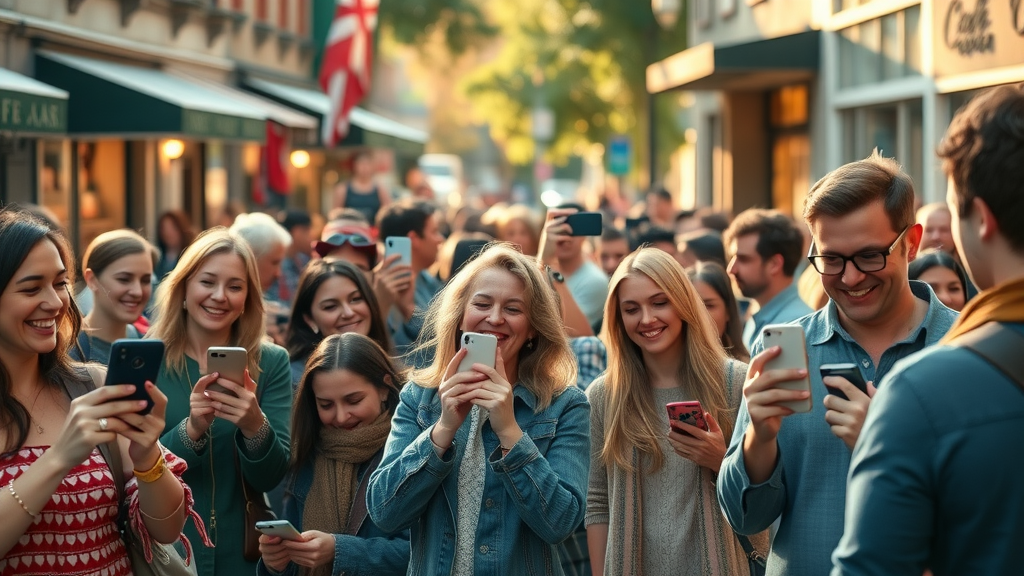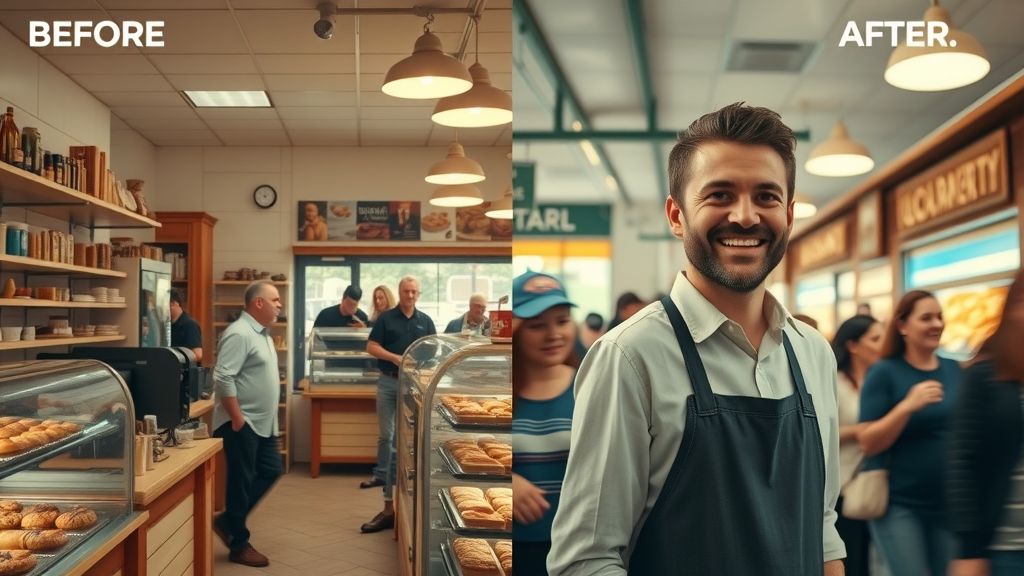Did you know that more than 85% of customers now discover their favorite local businesses directly through social media platforms? In today's fast-paced digital world, social media for local businesses isn't just an option—it's a necessity. Whether you're a corner bakery, a boutique shop, or a community cafe, leveraging the right media platforms , building real connections, and showcasing your unique story online can transform your entire business. Ready to learn the secrets the most successful local brands are using? Dive in for actionable strategies, vivid examples, and the proven steps you need to stand out and grow your small business.
How Social Media for Local Businesses Is Revolutionizing Community Engagement
- Did you know that over 85% of consumers discover local businesses primarily through social media platforms? This rapid transformation is reshaping how small businesses connect with neighborhoods and grow their customer base.
Social media for local businesses has reimagined the way small businesses interact with their communities. Platforms like Facebook, Instagram, and Google My Business let you join conversations, answer questions, and even spotlight neighborhood happenings in real time. Instead of waiting for foot traffic, business owners can jump into the digital conversation, inviting potential customers into their stores virtually first, and then physically. These platforms enable things like live Q&A sessions, behind-the-scenes content, and interactive polls that foster genuine relationships and build lasting trust.
The true power of social media for local businesses lies in its ability to humanize brands. Unlike traditional advertising, social media makes it possible to share the faces behind your business, tell your unique story, and showcase your products and services in a friendly, approachable way. When local customers engage with posts—whether by liking a photo of your new pastry, tagging friends to enter a contest, or sharing your event announcement—they become your advocates, helping you reach even more locals. For today's small business owner, social media isn’t just about posting offers; it's about building a community around your business.

Unlocking Opportunities: What Social Media for Local Businesses Can Do for You
- Gain practical insights into mastering social media marketing, tailoring your marketing strategy, boosting brand awareness, and outpacing competitors in your locale.
Unlocking the power of social media for local businesses gives you a direct line to your target audience. Social platforms let you announce new products or services, host flash sales, and promote special events within your community. More importantly, they help you collect feedback in real-time, giving you valuable insight into what your potential customers want. With the right marketing strategy , you can quickly adapt your messaging, refine your offerings, and respond to trends faster than larger competitors, keeping you ahead in the race for local loyalty.
Social media marketing also allows business owners to showcase their expertise and personality, establishing themselves as local thought leaders. Whether it’s a coffee shop sharing latte art tips on Instagram, or a hardware store hosting DIY sessions live on Facebook, these moments not only educate but also entertain your local community. Mastering media posts tailored to your neighborhood and target audience is the foundation for fostering customer loyalty and repeat business. With every story shared and every post boosted, your local business's reach and reputation expand exponentially.
For a deeper dive into the practical steps and common pitfalls of building your local presence, you might find it helpful to explore this guide on avoiding mistakes and maximizing results with social media for local businesses . It offers actionable advice to ensure your efforts stay on track as you grow your community connections.
Benefits of Social Media for Local Businesses
- The power of a targeted social media strategy: increasing visibility, elevating customer loyalty, expanding market reach, and cost-effective advertising for small business owners and small businesses.
Social media for local businesses offers a suite of substantial benefits that traditional advertising channels simply can't match. The biggest advantage is increased visibility—social media platforms serve as the modern-day Main Street, where potential customers discover shops, read reviews, and get excited about visiting in person. With location-based targeting, ads and posts can appear specifically to those nearby who are most likely to walk through your door, driving both foot traffic and awareness for your offerings.
Elevating customer loyalty is another game changer. Social media enables meaningful, two-way communication; quick responses to comments or DMs, celebrating local wins, and spotlighting loyal customers transform casual buyers into devoted fans. Plus, campaigns on platforms like Facebook and Instagram are remarkably cost-effective, helping small business owners maximize results even with modest ad spends—a crucial factor for businesses with limited marketing budgets.
“Social media puts your small business in front of your local audience every day – it's like having a billboard on Main Street, accessible for a fraction of the cost.”

Choosing the Right Social Media Platforms for Local Businesses
- Evaluating the best media platforms for your local business: Facebook, Instagram, and Google My Business
- Understanding local demographics on each social media platform
- Exploring location-based social media features
Choosing the right social media platform is vital for your small business. Not every platform delivers the same value for every industry or target audience. Facebook remains the most popular social media site among small businesses for its broad demographic reach, powerful advertising tools, and robust community groups tailored to specific locations. Instagram excels in visually-driven industries—think restaurants, boutiques, or salons—allowing high-impact photos and videos to showcase products and services. Google My Business is essential for hyper-local discovery, helping your business appear prominently in search engine results and Google Maps for local intent searches.
Understanding the demographics of each social network is crucial to crafting an effective marketing strategy. Facebook tends to attract a wide age range, perfect for community-centered outreach. Instagram is particularly popular with younger, visually-savvy consumers, often seeking new experiences and trending shops. Google My Business appeals to those searching for products or services “near me,” eager for instant solutions and reviews. Don’t forget to explore location-based tools on these platforms—features like Facebook check-ins, Instagram geotags, and Google local posts can drive real traffic and create buzz right where you operate.

| Platform | User Demographics | Local Features | Pros | Cons |
|---|---|---|---|---|
| Wide age range, community-focused, monthly active users in billions | Groups, Events, Local Ads, Check-ins | Powerful targeting, broad reach, strong community tools | Organic reach can be limited, requires active management | |
| Younger audience (18-35), visually driven, trending locally | Stories, Hashtags, Geotags, Shopping Tags | High engagement, great for products and services, creative visual options | Requires steady content creation, less long-form discussion | |
| Google My Business | Search-driven local customers, all age groups | Posts, Reviews, Q&A, Maps integration | Top visibility in search engine results, direct contact with potential customers | Fewer interactive features, limited media post variety |
Developing a Winning Social Media Marketing Strategy for Small Business
- Understanding your target audience and crafting content that resonates
- Using insights and analytics to guide your social media marketing
- Aligning your marketing strategy with business goals
A robust social media marketing strategy starts with a deep understanding of your target audience. Who are your ideal customers? What are their interests, habits, and local concerns? Pinpointing these details helps you craft tailored content that resonates, making your brand the familiar face in their online feeds. Crafting effective social media posts means asking: Does this help, entertain, or inspire my audience? Engaged followers are more likely to visit, share, and recommend your local business in person.
Use analytics provided by each social media platform —such as Facebook Insights or Instagram Analytics—to monitor what content drives the most results. Are people responding to behind-the-scenes photos, customer testimonials, or event announcements? Adjust your mix accordingly. Ensure your overall marketing strategy aligns with broader business goals: Do you want to drive traffic in-store, increase bookings, or boost brand awareness? Define tangible objectives before mapping out your monthly content calendar, keeping your efforts focused—and measurable—at every step.
Creating Compelling Social Media Posts for Local Audiences
- Tips for crafting attention-grabbing media posts and social media posts
- Best formats for engaging media post visuals (images, videos, polls)
- Storytelling and local flavor: what works for small businesses
Exceptional social media posts for local audiences go beyond promotions—they tell a story that highlights your business’s place in the community. Start with attention-grabbing visuals: high-quality photos of your products, staff, or happy customers; behind-the-scenes videos; or interactive polls about local preferences. Include a clear call to action, like inviting followers to tag a friend, stop by for a limited-time offer, or share their own experiences with your products or services. This not only boosts engagement but can amplify your reach organically as people interact and share.
Short, authentic videos and user polls work especially well for maximizing brand awareness and showing your business’s personality. For example, a quick video tour of your newly redecorated cafe, or a poll asking customers which pastry flavor to debut next week, can spark conversations and feedback. Remember, it’s the local flavor that makes your content stand out: spotlight staff stories, local collaborations, and the milestones that make your business unique.
“The best social media posts don’t just sell—they tell the story of your community and your business owner journey.”

Scheduling and Consistency: The Secret Weapon in Social Media for Local Businesses
- Best times to post on different social media platforms for local reach
- Using scheduling tools for social media post consistency
- Case studies: small businesses mastering the timing game
Posting at the right time is crucial, especially for local businesses seeking maximum engagement with their social media posts. Research shows that audiences in your time zone are most engaged before work (7-9 a.m.), during lunch hours, and later in the evening after dinner. By syncing your content schedule to these windows, your posts are more likely to surface when your community is active and ready to interact. Promoting an event or special offer? Schedule it several days in advance, then use reminders or stories to build anticipation and last-minute buzz.
Consistency is just as important as timing. Using scheduling tools like Buffer, Hootsuite, or Facebook Business Suite helps you plan a steady drumbeat of content—even during your busiest weeks. Successful business owners swear by batching: schedule a week’s worth of posts in one sitting and use automation to keep your feed fresh. Local case studies show that businesses who maintain regular posting see up to 4x the engagement and a significant spike in brand recall and visits.

Leveraging Local Influencers and User-Generated Content
- Collaborating with local influencers to boost brand awareness
- Encouraging customers to share their experiences through media posts
- Amplifying the reach of authentic local stories
Teaming up with local influencers is a powerful way to accelerate brand awareness for your business. These individuals already have credibility and reach within your target audience—and a single positive mention can bring dozens of new faces to your store. Reach out to micro-influencers (1,000–10,000 followers) in your community who align with your brand values. Offer a free product or invite them to exclusive events to motivate organic social media collaboration.
Encourage user-generated content by creating photo-worthy displays, running hashtag campaigns, or featuring customer stories on your profiles. When real customers share their experience, it builds social proof and trust faster than any advertisement. Amplifying these authentic voices—reposting their stories or offering small rewards—shows locals that you value them, while multiplying your reach in the community. Over time, this network effect is what helps local businesses go from hidden gems to must-visit destinations.
Paid Social Media Advertising for Local Businesses
- Overview: Facebook Ads, Instagram Promotions, and Nextdoor Sponsored Posts
- Targeting your local audience more efficiently
- Setting tangible goals and measuring ROI
Investing in paid social media advertising unlocks highly targeted growth for local businesses. Facebook Ads let you zero in on people based on location, age, interests, and behaviors, ensuring that your special offer or announcement reaches the right neighborhood. Instagram Promotions work best for visually appealing products or services, helping you get in front of local trend-seekers. Nextdoor Sponsored Posts are ideal for connecting with homeowners and residents in very specific geographic pockets, driving both awareness and in-store visits.
To maximize ROI, set clear and measurable goals—do you want more website visits, menu downloads, or in-person check-ins? Each platform’s analytics dashboard delivers real-time feedback so you can adjust your spend and creative approach quickly. Smart small business owners start with modest budgets, experiment with several ad types, and double down on those that drive the highest engagement and conversion rates. This approach ensures you only pay to reach the customers who matter most.
| Platform | Average Cost | Expected Results | Local Targeting Options |
|---|---|---|---|
| Facebook Ads | $0.50 - $2.00/click | Brand awareness, website visits, store visits | Geofencing, interest, age, lookalike audiences |
| Instagram Promotions | $0.70 - $2.50/click | Visual product/service discovery, engagement | Location, hashtags, demographic targeting |
| Nextdoor Sponsored Posts | $1.00 - $5.00/click | Neighborhood branding, resident trust | ZIP code, neighborhood, homeowner profiles |
Tracking Success: Metrics and Analytics for Social Media Marketing
- Key metrics: engagement, reach, conversions, and local brand awareness
- Tools for small business analytics on social media platforms
- Adjusting your marketing strategy based on data
Monitoring the right analytics ensures your social media marketing efforts generate real-world results. Focus on key metrics: engagement (likes, comments, shares), reach (total and local), conversions (website clicks, calls, reservations), and overall brand awareness in your market. Every major social network offers free or low-cost dashboards—use them! Compare which posts drive traffic, what times bring the most interaction, and which platforms convert viewers into actual customers.
Use simple tools like Google Analytics, Facebook Insights, and Instagram Analytics to track your progress weekly or monthly. Adjust your marketing strategy by doubling down on successful post types, altering timing, or testing new content formats. Small businesses that regularly calibrate their approach, based on hard data, consistently outperform those who set and forget their social campaigns.

Social Media for Local Businesses: Mistakes to Avoid
- Ignoring negative feedback or online reviews
- Posting inconsistently or off-topic
- Not localizing content or media posts
Even seasoned business owners can make mistakes that hurt their social media account performance. Never ignore negative feedback or reviews—instead, respond promptly and professionally to show you care about every customer. Posting inconsistently or veering too far off-topic is another common pitfall; it confuses your audience and undermines brand credibility. Most critically, failing to localize your content—by including neighborhood mentions, tying in local events, or using geo-specific hashtags—misses the most powerful advantage local businesses hold.
“An unattended social media account can harm your small business more than having no presence at all.”
Stay focused: Reply to customers, keep a regular posting schedule, and make your local connection the centerpiece of every media post . Avoid generic content that could come from any big-box brand and instead double down on what makes your business a true part of the community.
Social Media Tools and Resources for Small Businesses
- Top social media management and scheduling tools for local businesses
- Image and video creation tools for standout media marketing
- Free education and community resources
Equipping your business with the right tools makes managing a social media marketing plan easier and more effective. Look for management and scheduling apps like Buffer, Hootsuite, or Later, which allow for batch-posting and automatic scheduling—this keeps your feed active even when you're busy on the shop floor. For standout visuals, Canva offers drag-and-drop design templates, while Adobe Express and InShot boost your video content creation for platforms like Instagram and Facebook Reels.
Don’t overlook free education: Facebook’s Blueprint courses and local business Facebook Groups offer a goldmine of tips, while Google’s Digital Garage helps you build skills for search engine optimization and Google My Business. Building connections with other business owners through social media communities can also inspire collaborations and crowd-sourced solutions to shared challenges.

Case Studies: Social Media Success Stories for Local Business Owners
- Business owner spotlights: before and after social media marketing
- Innovative media posts that drove foot traffic and sales
- Lessons learned from small businesses thriving on social media
Consider Lisa’s Bakery : pre-social media, Lisa struggled to fill tables and relied on word-of-mouth. After launching engaging Facebook and Instagram posts featuring daily specials, behind-the-scenes baking, and customer shoutouts, her business saw weekend lines out the door. Promoting limited-time offers through stories and featuring loyal patrons in monthly “Customer of the Month” spotlights doubled foot traffic within 90 days.
Another great example is a local fitness studio that collaborated with neighborhood influencers on weekly challenges and shared client transformations. User-generated content and word-of-mouth referrals, amplified on social media, made class sign-ups soar. The main takeaway? Consistency, creativity, and celebrating community are the pillars of any successful local social strategy.

- Watch a breakdown of how social media platforms have transformed local business marketing.
- A step-by-step tutorial on designing an engaging media post to boost local community interaction.
- Learn strategies for collaborating with local influencers to drive awareness and sales for small businesses.
People Also Ask: What is the best social media for a small business?
- The best social media platforms for small businesses often include Facebook for its reach, Instagram for visual engagement, and Google My Business for search visibility. The choice depends on your target audience and industry.
People Also Ask: What is the 5 5 5 rule on social media?
- The 5-5-5 rule suggests sharing five pieces of content about your business, five curated pieces relevant to your audience, and five personal interactions, such as replies or likes, each week for balanced engagement.
People Also Ask: What is the 70/20/10 rule for social media?
- This content rule advises that 70% of social media posts should provide value (tips, education), 20% should share others’ content, and 10% should be promotional to keep your audience engaged without overselling.
People Also Ask: Which social media is well known for local marketing?
- Facebook and Google My Business are recognized leaders for local marketing. Both provide geo-targeting, community features, and tailored ads to attract nearby customers.
Step-by-Step Guide: Launching Social Media for Local Businesses
- Setting up business profiles on key social media platforms
- Optimizing your online presence for local search
- Crafting your first week of social media posts
- Engaging your first local followers
1. Set up your business profiles on Facebook, Instagram, and Google My Business. Include your business hours, contact info, and a short, keyword-rich description of your products or services.
2. Optimize for local search: Use your city or neighborhood in profile bios and posts, and select the right business category on every platform for search engine visibility.
3. Plan your launch week: Schedule a variety of social media posts: an introduction, behind-the-scenes, product highlights, customer testimonials, and a special local offer.
4. Engage your audience: Invite your loyal customers and personal network to follow and interact with your posts—respond quickly and encourage them to tag friends to build an early community.
Checklist: Daily Social Media Actions for Small Business Owners
- Replying to comments and messages
- Monitoring social media post performance
- Curating and posting relevant content
- Tracking new followers and engagements
A simple daily routine keeps your social media accounts active and engaging. Always reply to comments and messages promptly for great customer service. Check social media post analytics to see which content performs best and plan future topics. Curate local news or fun user posts to share, showing you’re a plugged-in community asset. Lastly, review your new followers and thank them for joining your journey to build loyalty from day one.
Expert Tips: Growing Local Brand Awareness Through Social Media
- Running local contests and giveaways
- Using hashtags tied to your location
- Collaborating with local events and businesses
Want rapid growth? Run local contests —ask followers to share a photo in your business or tag a friend to win a free item. Use location-specific hashtags (like #DenverEats or #SantaFeShopping) in every media post for discoverability. Team up with other small businesses for joint promotions or events; this exposes each brand to new segments of your shared audience.
“For small businesses, real growth comes from planting roots in your local social digital community.”

Answers to Common Social Media for Local Businesses Questions
-
How can a business owner handle negative online reviews?
Respond quickly, apologize when necessary, and offer to resolve the issue offline. Publicly addressing concerns shows you value all feedback and helps build trust with potential customers. -
What is the ideal posting frequency for small businesses?
Aim to post 3–5 times weekly on each platform to stay top-of-mind without overwhelming followers. Consistency is more important than volume for sustained engagement. -
Do all local businesses need to be on every media platform?
No. Focus on the 2–3 platforms where your target audience is most active and where your products or services shine best. Quality trumps quantity in social media for local businesses.
Frequently Asked Questions About Social Media for Local Businesses
-
What’s the minimum budget required for effective media marketing locally?
You can start with as little as $5–$10 a day on targeted ads to see results. As your audience grows, increase your investment for bigger impact. -
How can I target my exact local audience on social media platforms?
Most social networks offer geotargeting options. Choose locations, demographics, and interests that match your desired market for precise results. -
Is it worth hiring a social media manager for my small business?
If you have the budget, a dedicated manager can help you create, post, analyze, and refine your social content—saving you time and amplifying results.
Summary of Key Takeaways for Social Media for Local Businesses
- Use the right social media platforms for your audience and goals.
- Prioritize regular, authentic social media posts.
- Leverage local connections, influencers, and community partnerships.
- Track performance and adjust your marketing strategy frequently.
Ready to Transform Your Local Business with Social Media?
- Maximize your local impact—start implementing these social media for local businesses secrets today to stand out, engage your community, and grow your small business with confidence!
If you’re eager to take your local business’s social media to the next level, don’t stop here. Discover more advanced strategies, real-world examples, and the latest trends shaping local marketing by visiting our in-depth resource on staying ahead with social media for local businesses . Whether you’re just starting out or looking to refine your approach, you’ll find expert insights to help you adapt, innovate, and ensure your business never gets left behind in the digital age. Dive deeper and empower your brand to thrive in your community and beyond.
 Add Row
Add Row  Add
Add 




Write A Comment